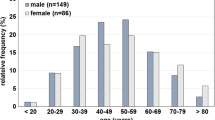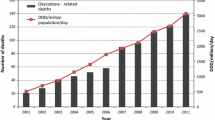Abstract
Inappropriate combinations of pharmaceutical drugs are often detected in deaths reported to a coroner. However, the involvement of drug combinations in the cause of death can be overlooked in cases when significant natural disease or external injury is also present. This study examined pathology reports and coroner’s findings between January 2002 and December 2008. Cases that included exposure to a selection of serotonergic drugs were examined to determine the role of different death investigators in drug-associated deaths in Victoria, Australia. Of the 326 cases identified, the involvement of drugs in the death was discussed to some degree in 66% of cases. Recommendations by the coroner pertaining to death prevention were made in 12 cases (4%). In 16 cases (5%) the drugs were not mentioned in the findings, including at least 11 cases of probable major adverse drug interactions. Death investigations serve an important public health and safety role, however, the potential involvement of drugs in many cases is not always recognized.

Similar content being viewed by others
References
Australian Bureau of Statistics. Drug-induced death, Australia, 1991–2001. Canberra, Australia (2003) Contract No. 3321.0.55.001.
Runciman WB, Roughead EE, Semple SJ, Adams RJ. Adverse drug events and medication errors in Australia. Int J Qual Health Care. 2003;15(Suppl 1):i49–59.
Drummer OH. Post-mortem toxicology. Forensic Sci Int. 2007;165(2–3):199–203.
Madea B, Musshoff F. Postmortem toxicology. Forensic Sci Int. 2004;142(2–3):71–3.
Curphey TJ. Role of the forensic pathologist in the medicolegal certification of modes of death. J Forensic Sci. 1968;13(2):163–76.
Vanezis P. The role of the pathologist in the investigation of unexpected death in infancy (cot death). Med Sci Law. 1981;21(2):119–20.
Manini AF, Nelson LS, Olsen D, Vlahov D, Hoffman RS. Medical examiner and medical toxicologist agreement on cause of death. Forensic Sci Int. 2011;206(1–3):71–6.
Bugeja L, Ranson D. Coroners’ recommendations: a lost opportunity. J Law Med. 2005;13(2):173–5.
Studdert DM, Cordner SM. Impact of coronial investigations on manner and cause of death determinations in Australia, 2000–2007. Med J Aust. 2010;192(8):444–7.
Brodie L, Bugeja L, Ibrahim JE. Coroners’ recommendations following fatal heavy vehicle crash investigations. Aust N Z J Psychiatry. 2010;34(2):136–41.
Pilgrim JL, Gerostamoulos D, Drummer OH. Deaths involving serotonergic drugs. Forensic Sci Int. 2010;198(1–3):110–7.
Department of Health and Ageing (DHA). Pharmaceutical benefits scheme expenditure and prescriptions twelve months to 30 June 2007.
Pilgrim JL, Gerostamoulos D, Drummer OH. Deaths involving contraindicated and inappropriate combinations of serotonergic drugs. Int J Legal Med. 2011;125(6):803–15.
Buajordet I, Ebbesen J, Erikssen J, Brors O, Hilberg T. Fatal adverse drug events: the paradox of drug treatment. J Intern Med. 2001;250(4):327–41.
Goldberg RM, Mabee J, Chan L, Wong S. Drug-drug and drug-disease interactions in the ED: analysis of a high-risk population. Am J Emerg Med. 1996;14(5):447–50.
Eap CB, Bertschy G, Powell K, Baumann P. Fluvoxamine and fluoxetine do not interact in the same way with the metabolism of the enantiomers of methadone. J Clin Psychopharmacol. 1997;17(2):113–7.
Boyer EW, Shannon M. The serotonin syndrome. N Engl J Med. 2005;352(11):1112–20.
Pilgrim JL, Gerostamoulos D, Drummer OH. Review: pharmacogenetic aspects of the effect of cytochrome p450 polymorphisms on serotonergic drug metabolism, response, interactions, and adverse effects. Forensic Sci Med Pathol. 2010;7(2):162–84.
Micromedex® healthcare series [database on the Internet] 1974–2010. 2010. http://www.thomsonhc.com.ezproxy.lib.monash.edu.au. Accessed: 16 July 2010
Acknowledgments
We thank the organization that maintains the National Coroners Information System for their help in obtaining mortality data. We also acknowledge the assistance of pathologists, forensic technicians and toxicologists at the Victorian Institute of Forensic Medicine.
Author information
Authors and Affiliations
Corresponding author
Rights and permissions
About this article
Cite this article
Pilgrim, J.L., Gerostamoulos, D. & Drummer, O.H. The role of toxicology interpretations in prevention of sudden death. Forensic Sci Med Pathol 8, 263–269 (2012). https://doi.org/10.1007/s12024-011-9309-7
Accepted:
Published:
Issue Date:
DOI: https://doi.org/10.1007/s12024-011-9309-7




